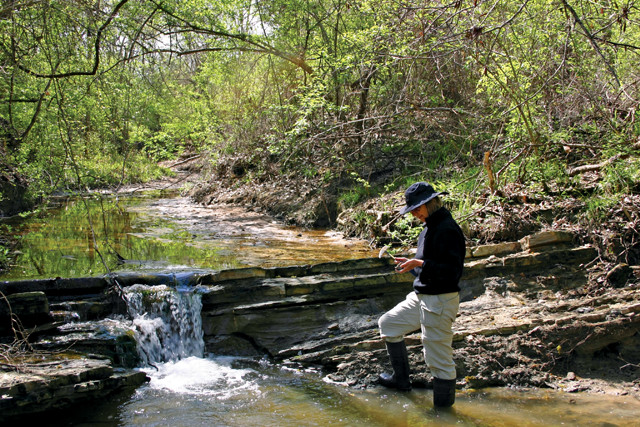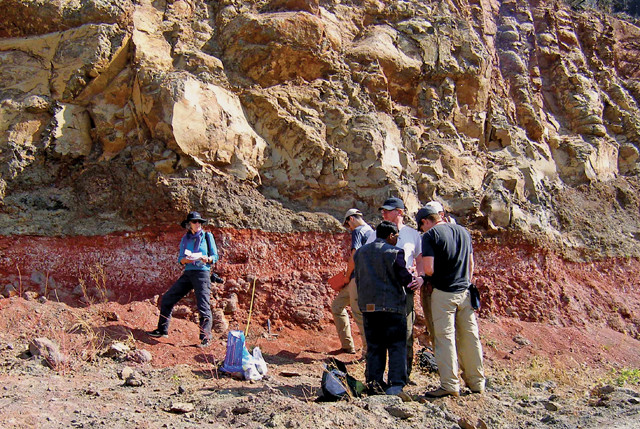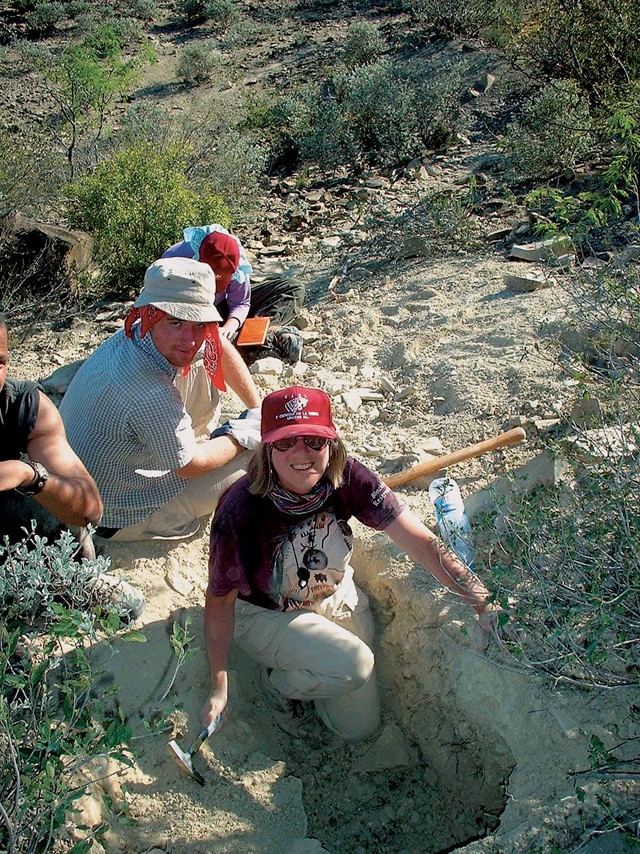
by Julia Rosen Thursday, April 20, 2017

Gerta Keller looks at sediment samples along the Brazos River in Texas. Credit: Gerta Keller/courtesy of NSF.
The mass extinction that did in the dinosaurs is one of the best-known events in geology. It’s also one of the most contentious.
For years, the accepted wisdom has been that a massive asteroid or comet slammed into Earth 66 million years ago, wiping out three-quarters of all species, including all nonavian dinosaurs. The idea was first proposed in 1980 by geologist Walter Alvarez and his father, Luis, a Nobel-prize-winning physicist. And it got a major boost in 1990 when geologists discovered the Chicxulub impact crater on the coast of Mexico’s Yucatán Peninsula. At that point, it seemed like a closed case.
But a small group of researchers, led by Princeton University paleontologist Gerta Keller, has long advocated for an alternative explanation. These scientists argue that a prolonged episode of intense volcanic activity in what is now India, which produced the flood-basalt deposits called the Deccan Traps, triggered the extinction that marked the end of the Cretaceous Period — a grim milestone known as the Cretaceous-Paleogene, or K-Pg, boundary. Eruptions of flood basalts can acidify the oceans and drive dramatic climate changes, and have been implicated in every other major mass extinction in the geologic record.
The two factions of scientists have rarely seen eye to eye, and the debate has, at times, turned bitter. In recent years, the volcanic hypothesis has enjoyed a renaissance, thanks to studies that have shown all three events — the eruptions, the impact and the extinction — occurred at about the same time. It’s tricky business sorting out exactly what happened millions of years ago, and a growing number of scientists have embraced the notion that both calamities may have played a role in the extinction.
Staunch as ever, Keller is not one of them. She still believes the volcanic outbursts that created the vast Deccan Traps were primarily to blame. EARTH sat down with Keller to talk about her upbringing in the Alps, her experience as an unwelcome critic of a mainstream scientific idea, and her long quest to understand the role of flood basalts.
JR: In a 2003 interview with the New York Times, you said, “I am in love with mountains and mountains are rocks.” Is that what first interested you in__ geology?__
GK:__ Yes. I grew up in the Swiss Alps and I always loved the outdoors and the mountains. I first majored in anthropology, but found that it wasn’t exactly satisfying. So I looked around for what else there was and I took a class called “Man and the Ice Age” from an old Swiss teacher Hans Thalmann. It was a really interesting course, and at the end, I asked him why he got into paleontology and geology. He said, “If you love mountains and you love travel, then you should become a geologist or paleontologist because you can always dream up a project anywhere in the world you want to go and somebody will pay for it.” It was great advice and it has served me very well.
JR: Much of your research focuses on mass extinctions and other catastrophes. What piqued your interest in__ disasters?__
GK:__ I became interested in mass extinctions as an undergraduate, when I was working with invertebrate fossils. There was a paper in 1967, “Revolutions in the History of Life,” by Columbia University paleontologist Norman Newell, that proposed mass extinctions played a significant role in Earth history. It was a very influential paper at the time. It’s really a classic, and that got me interested.
When I came to Stanford in 1974, I wanted to work either with plate tectonics or with extinctions. At the time, plate tectonics was a big deal, but somehow, I ended up doing paleontology. Mass extinction wasn’t a hot topic then. It was actually just something I was interested in. And I guess it never quite left me.
JR: You are a well-known critic of the idea that an impact killed off the dinosaurs at the K-Pg boundary. What first made you skeptical of that__ hypothesis?__
GK:__ I wasn’t skeptical to begin with. I thought it was a fantastic hypothesis, and if it were true, this was really very unique. At the time, I hadn’t started working on the K-Pg extinction yet. I was working on the late Eocene and Oligocene. I had discovered multiple layers of impact spherules in the late Eocene, and published a paper in Science in 1983. Luis Alvarez was very excited about it and, in late fall 1983, he invited me to a one-day meeting on mass extinctions at the Lawrence Berkeley National Lab to tell them about it. It was the first evidence that there could be multiple impacts, which, in theory, could cause mass extinction. He wasn’t too concerned that it didn’t cause mass extinction in the late Eocene.
At that meeting, the attendees assumed not only that the K-Pg impact had happened, but that it instantaneously killed off everything and caused mass extinctions. I had been reading up on the literature in paleontology — about what goes extinct and what doesn’t. And the literature showed that there was a long-term environmental change before the mass extinction. The impact hypothesis could not account for this pre-extinction environmental change. At the meeting, I raised my hand and said, “But the literature doesn’t show that.” And I became persona non grata.
After that, I decided I had to look into mass extinctions myself. But I waited five years, simply because I didn’t want to jump in when there was so much media hype about it. I figured that if I waited five years, then it would all have died down and gone away and I could do my work without political interference. I was never more wrong in my life! We are still at it, and it’s been over 30 years.

Keller (left) in India collecting the red bole layers between Deccan lava flows to extract zircon crystals for uranium-lead analysis, which can provide high-resolution ages for the lava flows. The field team includes Thierry Adatte, Preston Kemeny, Syed Khadri, Kyle Samperton and Blair Schoene. Credit: courtesy of Gerta Keller.
JR: You and others have argued that the eruption of the Deccan Traps played a major role in driving the extinction. What made you think that was__ important?__
GK:__ We did a lot of fieldwork looking at the K-Pg boundary in rocks in Mexico and Central America. We had accumulated so much data that showed there was simply no way that Chicxulub could be the sole cause for the mass extinction. Then the question was, “Where else do we look for an explanation?” And of course, Deccan volcanism was obvious. It’s been the elephant in the room that nobody wanted to address. I’ve been suggesting that this was a potential cause since 2003. The problem was that I didn’t have any direct evidence.
Then, in 2006 or 2007, my colleague, the geophysicist and volcanologist Vincent Courtillot, told me about a place in Rajahmundry in the eastern part of India, where there are marine sediments between Deccan Trap flows. There we found microfossils that first evolved after the mass extinction. That was the first break.
After that, we knew that the mass extinction was right in between some lava flows. But we didn’t have the layer containing the extinction itself, we only had the sediments with the new species evolving after the extinction. The question was, “Where can we get that with drilling?”
There is an area nealled the Krishna Godavari entially oil and gas land, and controlled by the national Indian oil and gas corporation. They drilled down 3,000 meters below the surface and through the lava flows. I thought, “OK,e need to look.” But everybody told me, “Forget it, there’s no way, they are so secretive. They have never allowed anybody outside their company to look at these cores.”
So, I invited myself to give a talk at their headquarters on the importance of the K-Pg boundary in India and the Deccan Traps, and basically how they may hold the key to it in the drilled cores. Much to my surprise, within three months, they agreed that I could have access to the cores. We published papers in 2011 and 2012, in which we could show, in a dozen drill cores across the area, that the mass extinction indeed happened between four major lava flows that erupted in western India and flowed a thousand kilometers across India to Rajahmundry and the Krishna Godavari Basin where we now had the data. That discovery basically started getting people re-interested in the Deccan Traps.
Later on, we discoveals in clay layers called red boles between Deccan Trap flows that my Princeton colleagues Blair Schoene and Kyle Samperton analyzed to more accurately date the eruptions. That was the second major break.
<strong class=““bolk”>JR: Many scientists are coming around to the idea that both events contributed to the extinction crises. Do you think both events were responsible to some__ degree?__
GK:__ Right now, I’m very skeptical. My current estimate is that the impact precedes the boundary by about 90,000 to 100,000 years. But the mass extinction really happened in the last few tens of thousands of years before the boundary.
The age estimate for the Chicxulub impact is based on our discovery of the impact spherule layer — 2 meters thick at El Peñon in northeastern Mexico. This layer is approximately 9 to 10 meters below the K-Pg boundary. Fossils of planktonic foraminifera that went extinct at the K-Pg are present in the sediments below and above this spherule layer and show no extinctions or even changes in their abundances. I’m not saying the impact didn’t have any effect. But based on the data we have, the effect was not long-lasting and caused no extinctions in the oceans. Within a few hundred years, life went back to normal. That, of course, is not exactly something that would support the impact hypothesis.
JR:I read that, as a girl growing up in Switzerland, you organized a protest against your school’s requirement that women wear skirts. Did these experiences prepare you for future professional__ battles?__

Keller, with undergraduate students Richard Lease and Steven Andrews, digging a trench at El Peñon, in northeastern Mexico, where they uncovered evidence of the Chicxulub meteorite impact. Credit: Gerta Keller, Princeton University/courtesy of NSF.
GK:__ It’s certainly true that I have questioned authority when it didn’t make sense to me. Not being able to wear pants to go three miles through high snow as a girl didn’t make sense to me. And that’s what I protested. We made it as far as being allowed to wear pants coming through the snow, but then we had to go to the bathroom and change into skirts. So it was very limited success.
Once I started studying the K-Pg, and I started finding things that did not fit the impact hypothesis, I simply tried to point out that the mass extinction was not instantaneous. There were climate or environmental changes before. When scientists denied that there was such a thing — even though the evidence was there — I couldn’t possibly not continue.
What drove me then was finding the real cause of this mass extinction. After 20 years of the K-Pg impact hypothesis being the dominant theory, it clearly could not account for all the changes we saw. The search for truth is what kept me in the game. Maybe it was also because of all the names that I was called, and all the backstabbing and bullying that I endured — that’s not exactly likely to make me change my mind.
JR: Do you see yourself working on the K-Pg extinction for the rest of your__ career?__
GK:__ I am now at the age where I’m not going to change my career. This is the time to consolidate it all and really nail this baby down. And that’s essentially what we are doing with the Deccan Traps. Once we’ve done that, I’ll be satisfied with what I have achieved. I will continue to be involved in science because there are so many more aspects to really understand mass extinctions.
I’m happy to say that today there is strong evidence that virtually every mass extinction — all five major ones — are associated with volcanic eruptions. And that should tell us that volcanism is a very important part in the evolution of life.
© 2008-2021. All rights reserved. Any copying, redistribution or retransmission of any of the contents of this service without the expressed written permission of the American Geosciences Institute is expressly prohibited. Click here for all copyright requests.